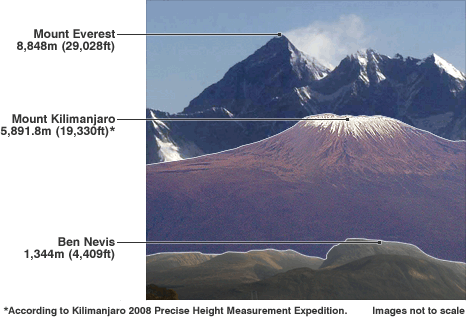Are you planning a trek and trying to decide between either Everest Base Camp or Kilimanjaro? I have been to both and wanted to put together a bit of a comparison of the experience on each. This comparison looks specifically at the Kilimanjaro’s Marangu Route which is the quickest and also one of the most popular summit approaches. The other routes to Kilimanjaro’s summit take more time and give trekkers a better chance to acclimatize.
THE TRAIL
There are several different routes for summiting Kilimanjaro, some
are shorter and steeper, while others are longer and have less of a
grade. I choose the latter trail to better cope with the elevation
change. The specific route I took was the Lomosho route, which took
about 8 days from the start to the end.
As for Everest Base Camp(EBC), there really isn’t much variation in the
route to the base camp. We started our trek from Lukla after we landed
at the notoriously extreme airport.
There are other points of interest in the Everest Region such as summiting Island Peak(Imja Tse), which would add days to your itinerary than trekking to EBC and back down. On Kilimanjaro, there are other points of interest such as crater camp, which I didn’t do.
View of Mount Everest
Everest or Kilimanjaro: The Scenery and Trekking Experience
Kilimanjaro and Everest both offer vastly different trekking
experiences. The scenery on the Everest Base trek is incredible once you
pass Namche Bazaar on the third day the views of the peaks are
spectacular. The trail passes below the base of Ama Dablam (the
Matterhorn of the Himalayas) and the trek offers views of 4 of the
world’s 14 eight thousand meter peaks which include; Cho Oyu, Lhotse,
Makalu and of course Everest. Kilimanjaro is a free standing peak and
can’t offer the same mountain scenery but still provides an interesting
experience as you traverse through the different eco-zones. The trek to
Kilimanjaro starts off in the lowland rainforests at the base of the
mountain which gradually thin and transition to cloud forest (heath
zone) where bearded mosses and lichens covers the short stubby trees in
the moist and often misty air. Leaving the Heath Zone one enters the
Mooreland Zone which is a unique zone of vegetation well known for its
Giant Lobelia and Groundsels (See photo).

Mount Kilimanjaro Route
The actual trekking experience also varies quite a bit. Kilimanjaro offers a mountain hut system on the Marangu Route and camping on other routes. The huts which are run by the national park service are comfortable and in the lower camps each small room is shared between four people. The huts provide a mat to sleep on and lighting but no electrical outlets. The “Tea House” experience in Nepal is quite a bit different and I think the hospitability of the Sherpa culture is part of the trekking experience that can’t be replicated in a hut system run by a national park service. On the Everest trek you will be hiking through small village’s dependant on tourism for their livelihood and offering the visitors a range of restaurants, lodging options and shops selling everything from souvenirs to snacks
Tengboche Monastery Everest Trek
Everest or Kilimanjaro: When to go + Weather and Seasons
Everest
Base Camp can be trekked anytime from October until June. The Everest
Trek can be quite cold during December and January but it is one of my
favorite times of year as the crowds are completely absent and you have
the mountain to yourself. Kilimanjaro has two seasons and is good
climbing from June to September and during January and February. The
busiest month on Kilimanjaro is September and January is the least busy
month with typically good weather conditions.
CULTURAL IMMERSION
If you want a little cultural on your trek, definitely go with the EBC
trek. Each teahouse along the trek resides in villages where locals live
year round. This gives you an opportunity to meet locals and their
children. On Kilimanjaro, it’s virtually all tourist that congregate at
the campsites. There are no local villages on the mountain, thus leaving
no opportunity to interact with locals other than your guide and
porters.
View of Everest an and Lhotse from Namche Bazar
SLEEPING FACILITIES
The facilities found on the EBC is much more comfortable than camping on
Kilimanjaro. I roughed it and had sleeping pads and a sleeping bag.
Some other guide companies actually have taller standing tents with
cots. So it all depends on how much you want to pay. On the EBC trek,
all my accommodations were in tea houses where we slept indoors on foam
mattresses with sleeping bags.
Sleeping conditions on Everest Base camp
sleeping conditions on Kilimanjaro Base camp
Side-by-side Comparison
Number of Climbers: 40,000 Kilimanjaro
Number of Trekkers : 45,000 Everest Base Camp
Number of Days to Everest Base Camp: 10 Days
Number of Days to Kilimanjaro Summit: 5 Days
One Way Elevation Gain EBC: 4200m / 13900feet
One Way Elevation Gain Kilimanjaro Marangu Route: 4000m / 13100ft
Kilimanjaro Marangu Route Roudtrip Distance: 70km (42 miles)
Everest Base Camp Roudtrip Distance: 122km (76 miles)
THE REWARD AT THE END
The end point of EBC is kind of anti-climatic with a vista that’s not
entirely self-rewarding. It’s essentially a rock with prayer flags
marking the general area where Everest summit expeditions setup camp.
Contrast this to the Kilimanjaro trek, the summit provides a view of
the sunrise(assuming you depart for the summit at night). Though, it was
too cold to stay at the summit and enjoy the scenery. Despite taking a
better part of 8 hours to, I only ended up staying at the summit for 15
minutes.
Here’s a few pictures showing the end point for Kilimanjaro and Everest
Top of the Mount Kilimanjaro
Top Of Mount Everest
Hope this information will be helpful to all of you :)
Source for the images:-





























